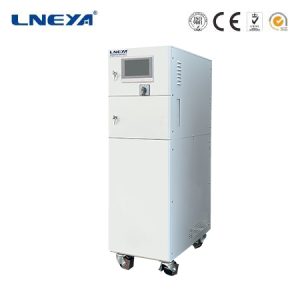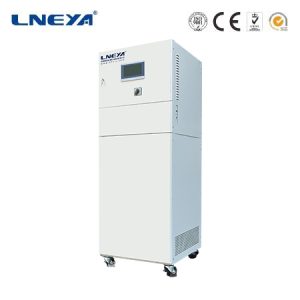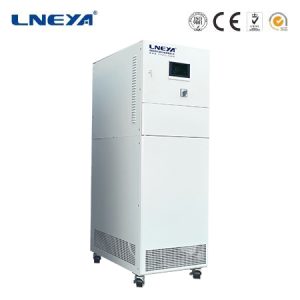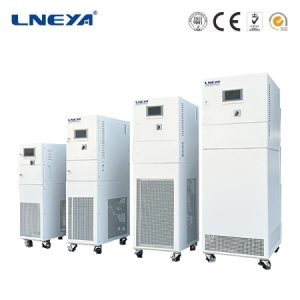Lithium Battery Cooling System
Contact us today for the perfect temperature control solution
The design goals of the power battery thermal management system are: to adjust the battery temperature to keep it within the suitable operating temperature range of the battery; to reduce the difference between the maximum temperature and the minimum temperature in the battery pack.
1. Liquid cooling system composition
Liquid cooling systems are currently a popular research direction in power battery thermal management. The cooling liquid has a large heat capacity and can take away excess heat from the battery system through circulation to achieve optimal operating temperature conditions for the battery pack.
The basic components of the liquid cooling system include: electric water pump, cell radiator (indirect cooling), temperature sensor, air conditioning system (compressor, condenser, evaporator), heater, and liquid-to-liquid heat exchanger.
Among them, the air conditioning system is responsible for providing cooling function under high temperature conditions; the heater is responsible for heating the coolant under low temperature conditions.
2. Heat transfer principle
The original design intention of the thermal management system is to transfer the excess heat of the power battery during the charging and discharging process, to keep the battery working within a suitable range, and the temperature difference between the cells in different locations should not be too large. In this way, it can not only slow down the aging rate of the battery, but also slow down the deepening of differentiation between different cells.
The reason why there are different cooling forms such as air cooling and liquid cooling is mainly because the heat transfer media are different. In principle, we need to start with the different heat transfer methods. There are three main forms of heat transmission: thermal radiation, thermal conduction and convection.
Thermal radiation: Objects with a temperature higher than absolute zero are radiating heat. Thermal radiation does not require a medium or contact, and transfers heat outward in the form of electromagnetic waves. The heat transferred from the sun to the earth is a typical process of thermal radiation.
Heat conduction: The process of transferring heat from a high-temperature area to a low-temperature area through a medium. Different from thermal radiation, heat conduction requires the existence of two conditions: temperature difference and medium.
Convection: Relative flow within a fluid driven by temperature differences.
Heat is transferred inside the power battery cell to the battery surface mainly through thermal conduction, and then to the surrounding space through radiation and convection. If a thermal management system is added to the system, the heat transfer process is partially changed. For example, in the indirect heat dissipation method, the heat is transferred from the battery surface to the radiator shell mainly by thermal conduction, and then transferred from the shell to the radiator flow channel surface by thermal conduction; the heat is transferred from the flow channel surface to the coolant by thermal conduction. , the coolant transfers heat inside the coolant in a convection manner, and follows the forced flow of the coolant to the outside of the battery pack.

3. Thermal management solution for battery pack
The thermal management solution for the battery pack involves measures in three aspects: battery pack cooling, battery pack low-temperature preheating, and battery pack insulation.
Battery pack cooling
The cooling function of the liquid cooling system is mainly realized by circulating low-temperature coolant. If the required heat dissipation power is relatively small, since the heat capacity of the coolant itself is relatively large, there is no need to start the cycle process, and the set temperature range requirements can be met.
There are two main forms of battery pack cooling, direct cooling and indirect cooling. Direct cooling means that the cooling medium flows directly from the surface of the battery core to take away excess heat; indirect cooling means that the cooling medium flows through the flow channels of pipes and radiators. The radiator is in contact with the battery core and transfers the heat of the battery core to the cooling system. medium.
Low temperature preheating of battery pack
Originally, the compressor could have a heating function, but its low-temperature heating effect is not good and it consumes a lot of power, which has a great impact on the battery life. At the same time, when the temperature is too low, the battery pack discharges too much power. The temperature is too low or simply lower than the minimum discharge temperature and cannot be discharged. Therefore, a preheating process before starting the car is designed in the thermal management strategy.
There are two basic forms of low-temperature preheating of the battery pack: internal heating and external heating.
Internal heating uses the AC power outside the battery pack to heat the battery electrolyte until it reaches the applicable temperature range of the battery pack. The component that generates heat is the battery itself, hence the name internal heating.
External heating uses external power to heat the medium other than the battery. The medium transfers heat to the battery, gradually increasing the battery temperature until the battery reaches a suitable temperature range. External media include air media and liquid media, and heat-generating components include PTC and heating films.
External heating is the more common method. The general implementation form is that the battery pack is equipped with a heater inside, which does not use the power of the power battery. Instead, in the parking state, a power source other than the battery pack is connected to supply power to the PTC or heating film. The external power supply is generally electric energy from the large power grid. The heater can work at the applicable maximum power without having to worry about the waste of electric energy. The overall heating rate is relatively high.
Battery pack insulation
For power battery packs used in low-temperature areas, the box generally needs to be designed with insulation measures to slow down the loss of preheating heat. This prevents the battery from dropping below the operating temperature again when the vehicle is stopped for a short period of time while driving. Experiments have shown that the ambient temperature is minus 20°C. During the preheating process, the battery is heated to 25°C and the vehicle is left standing for 8 hours, and the temperature drops to about 18°C.
Insulation measures are not provided in every vehicle with thermal management functions. After the vehicle is preheated and the battery pack enters working status, the battery itself will generate a large amount of heat. If the environment is not extremely cold and there is no need to park for a long time, the operating temperature of the battery pack can be maintained by its own heat.
4. Main factors affecting cooling effect
Coolant temperature. During the cooling process, the lower the temperature of the coolant, the lower the maximum and minimum temperatures of the battery, but the gap between the two is large. During the heating process, the higher the temperature of the coolant, the greater the temperature difference of the battery. In other words, the greater the temperature difference between the coolant and the battery, the greater the temperature difference will be between the cells at different locations inside the battery pack.
This phenomenon is mainly related to the different degrees of influence of the temperature adjustment of the thermal management system on the cells at different locations. Some batteries have a large contact area with the radiator, while others are relatively small. On the other hand, during the circulation of the coolant inside the battery pack, the temperature keeps changing from the inlet to the outlet. At different locations, the temperature difference between the coolant and batteries with the same body temperature is different. Only precise thermal design can solve this problem, rather than simply adjusting the coolant temperature.
Coolant flow. The greater the coolant flow rate, the more heat will be taken away in the same period of time. There is a simulation that specifically observes the impact of the coolant flow on the cooling effect of the liquid cooling model when other parameters are kept unchanged and only the coolant flow is adjusted. As the coolant flow increases, the maximum temperature of the battery system decreases, but the temperature difference increases. After passing a maximum temperature difference point, the flow rate continues to increase, and the temperature difference begins to decrease. As the flow continues to increase, the maximum temperature and temperature difference continue to decrease in one direction.
In the first half of the flow increase process, the maximum temperature decreases and the temperature difference increases. The reasons are consistent with the effect of the continuous decrease in coolant temperature. They are all related to the specific thermal structure design. Different cooling effects bring different temperature changes. In the second half of the flow increase test, as the flow rate increases, the temperature difference begins to decrease and continues to decrease. This is because the flow rate of the coolant increases to a certain extent. Compared with the heat absorption capacity of the coolant, the battery transfers to the coolant. The heat is relatively small. In this way, on the one hand, the influence on the temperature of the coolant becomes smaller, and the temperature difference between the coolant at different locations far and near from the system inlet becomes smaller and smaller; on the other hand, the difference in heat transfer capacity caused by the difference in the heat transfer area of different cells , is also getting smaller relatively. As a result, the overall temperature difference of the system continues to decrease.
But traffic cannot continue to increase. On the one hand, it is related to the amount of energy consumed, so you must choose the flow with the best cost performance. On the other hand, maintaining a large flow rate for a long time is a test of the strength of the coolant circulation system, and the life of the equipment may be reduced. At the same time, the risk of accidents increases.
Email: info@lneya.com WeChat ID: +8615251628237 WhatsApp: +86 17851209193
 LNEYA
LNEYA
 简体中文
简体中文



















































































